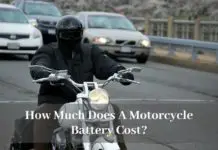
Ever pressed your motorcycle’s start button and merely heard a faint click or worse – silence? Yes, I have and more often than not, it was because of a bad motorcycle battery.
Doing a simple check on your motorcycle before using them only takes a moment of your time.
In such a condition, where the motorcycle refuses to start, we normally feel frustrated mainly because of our failure to check on some simple details that landed us in such a situation anyways.
So how can you tell about the signs of a bad motorcycle? The easiest way to determine if your battery is bad or faulty is to conduct a physical check on it. Take a look and check if it has a broken terminal, the battery case has a bulge, bump or crack, leakage and / or discoloration.
Alternatively, you may also go to the front of your bike and if the headlight is weak it typically means you have a battery problem.
What can we do to avoid a cancelled ride with friends due to unchecked batteries? I have done some research and collected the most helpful and simple steps to conduct a simple inspection of your motorcycle battery. You do not even need to bring your motorcycle to mechanic. This, at the end of the day, can save you time and money.
How To Maximize The Life Span Of Your Motorcycle Battery
Motorcycle batteries are expected to last up to 4 to 6 years maximum with proper attention given to it. Read on to save money with just a few easy steps:
1. Apply Safety Precautions When Handling Batteries
For safety purposes, always wear rubber gloves and eye protection such as eye googles when handling lead-acid batteries. Always clean up any water, oil or chemical spills as soon as possible to avoid accidents. For acid spills, you may wipe it with a baking soda solution.
Make sure that your work area is well-lit and well-ventilated as gas from the battery are flammable and explosive. With this in mind, always clear your workspace and keep children and pets away.
2. Conduct A Monthly Physical Test On Your Batteries
As in everything, it is always best to be aware of preventive measures that can help us avoid having a dead battery during critical times. As mentioned above, this is the easiest way to check if you have a bad battery as it only requires your sense of sight, no other tools or equipment is needed.
If any of the signs mentioned above is observed, It is best to replace your battery for safety purposes.
3. Check For Corrosion
The presence of corrosion does not mean your battery is already faulty or dead, it only means you have neglected your duty as an owner and failed to clean your battery. Note that cleaning your battery should be done on a monthly basis at least.
How To Remove Or Prevent Corrosion From Your Battery
Step 1: Prepare the following tools – toothbrush or wire brush, vaseline or di-electric grease, spray container and cloth.
Step 2: Apply the baking soda solution using a brush or spray it on the terminal. Let it sit for at least 5 minutes. If corrosion is already present, brush it off using a wire brush or a toothbrush.
Step 3: Wipe it dry using a clean cloth.
Step 4: Coat the exposed metal area of the terminal with grease or petroleum jelly. This would assist in slowing down the formation of corrosion deposits.
Step 5: Check for loose connections. Reconnect cables as needed.
Step 6: While cleaning your batteries, include to check the electrolyte level of your battery and distilled water should be added as needed to keep the electrolyte at a healthy level
With or without corrosion, the steps enumarated should be done once a month.
Check For Leakage (Oil, Water or Acid)
Should you find that any type of liquid is going inside the battery casing, seal it right away. Liquid matter can make the metal connectors of the battery to become rusty and can be the cause of a defective motorcycle battery.
Should you find yourself in a position where you feel like you have done your due diligence in the proper maintenance of your motorcycle battery but your motorcycle would not start, do the following:
Take A Voltage Reading
If your battery looks fine and shows no immediate sign of breakage, check for voltage output using a multimeter. Make sure that your motorcycle is completely off prior to conducting this test.
The black lead of the multimeter should be connected to the common ground port ordinarily labelled as “COM”. The red lead should be connected to the port labelled with a “V”. Turn the multimeter on to 20V DC.
Be mindful of the following findings:
If your multimeter reading gives you zero voltage, it may mean that the battery has short circuited.
If your motorcycle battery is being charged but the multimeter reading only gives you less than 10.5 volts, it may mean your battery has a dead cell.
If your motorcycle battery is fully charged but the multimeter reading gives you 12.4 volts or less, it may mean that your battery is sulfated. Sulfation is when sulfuric acid crystals cannot be converted back into an active plate material and ruins the battery.
This can be prevented by simply charging the battery in a timely manner. Do not let your battery be discharged for long periods of time.
Conduct A Load Test
This activity requires a digital voltmeter and your motorcycle battery to be fully charged.
Be mindful of the following findings when conducting this test:
If your motorcycle battery gives you a range of 9.5 volts to 10.5 volts for 30 seconds, that means you have a good healthy battery.
If the voltage instantly drops, then there is a battery problem and may require to be replaced. (Read this article if you are interested in leaning about motorcycle battery voltage range).
Factors To Consider In Purchasing A Motorcycle Battery
Check for compatibility. Not all motorcycle batteries have universal compatibility. Thus, getting yourself familiarized with your motorcycle’s manual is a must. Always check on your motorcycle specifications to match it properly with the battery.
Decide on either a Gel Type Battery or an AGM (Absorbed Glass Mat) type battery. Both types have their own benefits wherein Gel Type Batteries is versatile and can be used for different applications. AGM type batteries on the other hand guarantees no leakages should your battery casing breaks.
Check for warranty. Always choose a product with extensive warranty service. This guarantees support from the manufacturer should you have any issues with the battery and would give you peace of mind at least for a few years.
Settle for low maintenance batteries. With busy lives, let’s be honest, we do not normally have the time to conduct these supposedly routinary steps in maintaining our motorcycles.
Check on the power ratings. This indicates the overall performance of the battery. The higher the rating, the more expensive it is.
Check for product reviews. Information is made readily available to us in this day and age. Utilize your available resources and read through the reviews. What other people say can influence your decision and ultimately guide you in making the right one.
Of course, not all motorcycles refusing to start is caused by bad batteries, there are also other factors you may want to consider. Read on to know more and see possible fixes that you can apply.
1. Your Motorcycle May Have No Fuel
A simple but mostly overlooked factor in start-up issues. Shake your motorcycle gently and listen for a sloshing sound. Should you hear a sloshing sound, It is a sure tell-tale sign that fuel is present in your tank.
2. Your Fuel Tank Vent Might Be Clogged
Should there be fuel, check for a clogged fuel tank vent. In most cases, If this vent gets clogged, it holds the supply of fuel to the rest of your motorcycle system thereby hindering the bike to function as needed.
In other words, your motorcycle thinks it has no fuel when in actuality it has. This can be fixed by simply poking the vent with a thin wire and letting the air circulate again.
3. Your Clutch May Not Be Engaging Properly
Technical reasons may cause your clutch to not engage correctly. Should this happen, switch to neutral and try to engage the clutch again.
4. Your Exhaust Might Be Blocked
This might be due to a number of reasons such as an ill-maintained exhaust or pranksters. Nevertheless, better to tick this off your checklist. How to fix? Just remove the blockage and you should be good to go.
5. Your Spark Plug Might Be Loose
This, also, might be due to pranksters or actions made by us. How to fix? Just unplug and re-plug the connectors and attempt to start the motorcycle again.
Final Thoughts
Regularly checking for signs of a bad battery on a motorcycle should be part of your maintenance activity. This will help you avoid bad situations that could ruin a good ride with friends. Additionally, this would also help extend the life span of your battery.





